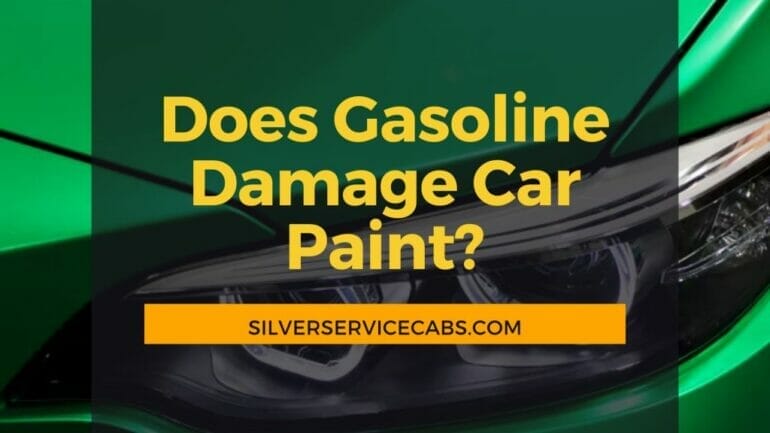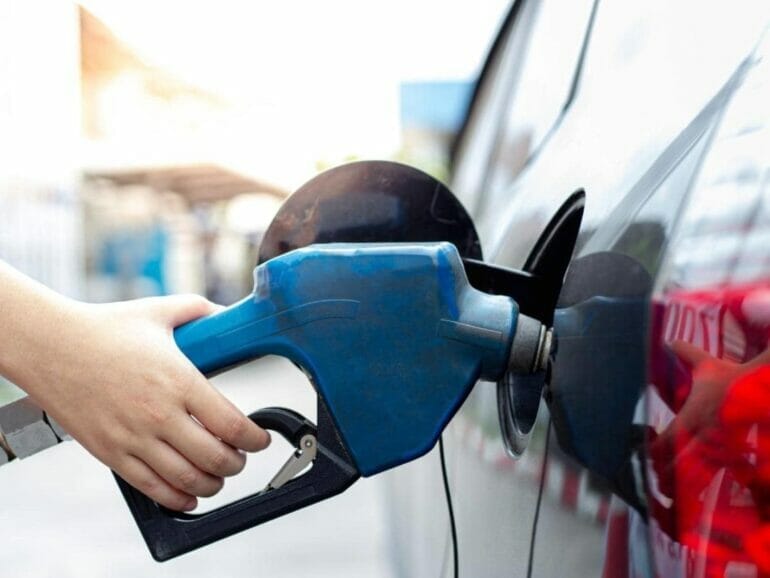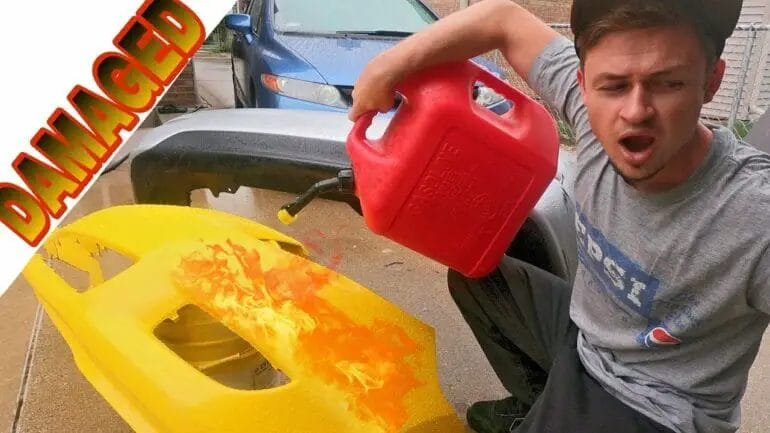If you’re wondering whether gas can ruin your car paint, the answer is not quite straightforward. While gasoline itself does not typically cause immediate damage to car paint, prolonged exposure or spills can lead to discoloration and weakening of the paint finish. Additionally, the chemicals and additives present in gasoline can potentially strip away the protective wax layer and leave the paint vulnerable to environmental elements. So, it’s important to be cautious and promptly clean any gas spills to maintain your car’s paintwork.

Tips to Protect Your Car Paint from Gas Damage
One of the common concerns for car owners is protecting their car’s paint from damage caused by gasoline spills or drips. Gasoline contains chemicals and solvents that can harm the paint and leave unsightly stains if not properly cleaned. To help you protect your car’s paint from gas damage, here are some useful tips:
1. Be cautious when refueling
When refueling your vehicle, it’s important to be careful and avoid any spills or drips. Start by turning off the engine and removing any static electricity by touching a metal surface before handling the fuel pump. Take your time and position the fuel pump nozzle properly to avoid any splashing or overflowing.
2. Keep a clean rag or towel handy
Accidents can happen, and if you accidentally spill gasoline on your car’s paint, it’s crucial to act quickly. Always have a clean rag or towel in your car that you can use to immediately wipe off any spills. The longer the gas sits on the paint, the more damage it can cause. Remember to blot the area instead of rubbing to prevent spreading the gasoline.
3. Use a high-quality car wash soap
Regularly washing your car with a high-quality car wash soap can help protect the paint from gas damage. Look for a soap specifically designed for automotive use, as it will have the right balance of cleaning power and gentle ingredients. Avoid using harsh detergents or household cleaners, as they can strip away the protective wax layer on your car’s paint.
4. Wax your car regularly
Applying a layer of wax on your car’s paint provides an additional protective barrier against gasoline and other contaminants. Waxing helps create a smooth surface that makes it easier to clean off any spills. Choose a high-quality car wax and follow the manufacturer’s instructions for application. Regular waxing will also help maintain the shine and integrity of your car’s paint.
5. Park away from gas pumps
Another preventive measure is to park your car away from the gas pumps whenever possible. This reduces the risk of accidental spills from other vehicles or pump malfunctions. Choosing a parking spot away from the pumps gives you more control over avoiding gas splashes or drips that could damage your car’s paint.
6. Clean spills immediately
If you do happen to spill gasoline on your car’s paint, it’s vital to clean it up promptly. Use a clean cloth or rag dampened with water and a mild soap solution to gently wipe away the gasoline. Avoid using abrasive materials or scrubbing too hard, as this can cause further damage to the paint.
7. Consider protective film or coating
If you frequently find yourself in situations where the risk of gas spills is high, you might want to consider applying a protective film or coating on your car’s paint. These products provide an extra layer of protection and can be effective in preventing damage caused by gasoline and other chemicals.
In summary, protecting your car’s paint from gas damage requires caution, prompt action, and regular maintenance. By following these tips, you can minimize the risk of unsightly stains and keep your car’s paint looking pristine.

How to Safely Clean Gasoline Spills on Car Paint
Gasoline spills on car paint can be a common occurrence, especially when refueling your vehicle. If not cleaned properly, gasoline can damage the paint and leave unsightly stains. In this section, we will discuss the steps you can take to safely clean gasoline spills on your car paint, ensuring that your vehicle remains in pristine condition.
Gather the Necessary Supplies
Before you start cleaning the gasoline spill, it is important to gather all the necessary supplies. Here’s a list of items you will need:
- Microfiber cloths or soft towels
- Mild car wash soap
- Bucket of water
- Isopropyl alcohol
- Automotive wax
Remove Excess Gasoline
The first step in cleaning a gasoline spill is to remove any excess gasoline from the affected area. You can use a cloth or paper towel to gently blot the spill and absorb as much gasoline as possible. Be careful not to rub the spill, as it may spread and cause further damage to the paint.
Wash the Area
After removing the excess gasoline, it is important to wash the affected area thoroughly. Mix a mild car wash soap with water in a bucket to create a soapy solution. Dip a microfiber cloth or soft towel into the solution and gently scrub the spill area in a circular motion. Rinse the cloth frequently to avoid spreading the gasoline residue.
Remove Stains with Isopropyl Alcohol
If the gasoline spill has left behind stubborn stains on the car paint, you can use isopropyl alcohol to remove them. Moisten a clean cloth with isopropyl alcohol and gently rub the stained area. Be careful not to apply too much pressure, as it may damage the paint. Repeat this process until the stains are completely removed.
Apply Automotive Wax
Once the gasoline spill and stains have been successfully removed, it is recommended to apply a layer of automotive wax to protect the paint. Apply a small amount of wax onto a clean cloth and gently buff the affected area in circular motions. This will help restore the shine and provide a protective barrier against future spills.
Dispose of Cleaning Materials Properly
After completing the cleaning process, it is important to dispose of the cleaning materials properly. Gasoline-soaked cloths or paper towels can be a fire hazard, so make sure to store them in a sealable container and dispose of them in accordance with local regulations.
Summary
Gasoline spills on car paint can be effectively cleaned by following these steps:
- Remove excess gasoline by blotting with a cloth or paper towel.
- Wash the affected area with a mild car wash soap and water.
- Remove stubborn stains with isopropyl alcohol.
- Apply automotive wax to protect the paint.
- Dispose of cleaning materials properly to ensure safety.
By taking these precautions and following the proper cleaning techniques, you can safely and effectively remove gasoline spills from your car paint, keeping your vehicle looking its best.

Common Signs of Gasoline Damage to Car Paint
Gasoline is a commonly used fuel for vehicles, but it can also cause damage to car paint if spilled or splashed onto the surface. Knowing the signs of gasoline damage to car paint can help you identify and address any issues before they worsen. In this section, we will discuss some common signs to look out for.
1. Discoloration
One of the most noticeable signs of gasoline damage to car paint is discoloration. If gasoline comes into contact with the paint, it can strip away the protective clear coat and pigment, leading to a change in color. The affected area may appear faded, discolored, or even have a rainbow-like sheen. It is important to address discoloration promptly to prevent further damage.
2. Blistering
Another sign of gasoline damage is blistering on the car paint. Gasoline contains chemicals that can react with the paint’s surface, causing it to bubble and form blisters. These blisters can range in size and may be accompanied by a rough texture. If left untreated, the blisters can worsen and lead to paint peeling or flaking.
3. Peeling or Flaking
If gasoline damage is severe, it can result in peeling or flaking of the car paint. This occurs when the gas has penetrated through the paint layers, causing them to separate from the underlying surface. Peeling or flaking paint is not only unsightly but can also expose the metal body of the car to rust and further deterioration.
4. Etching
Gasoline is known to contain corrosive elements that can etch into the car paint if left on the surface for an extended period. Etching appears as small, pitted spots or rough patches on the paint. These spots can be difficult to remove and may require professional intervention to restore the paint’s smoothness.
5. Strong Odor
If you detect a strong gasoline odor coming from your car, it could indicate a fuel leak or spillage that may have damaged the paint. The odor may persist even after cleaning the surface, indicating the need for further inspection and repair.
6. Staining
Gasoline can leave behind stubborn stains on car paint. These stains may appear as dark or discolored patches that are difficult to remove with regular washing. Cleaning the affected area promptly can help minimize staining and prevent it from becoming permanent.
In summary, gasoline damage to car paint can manifest in various ways, including discoloration, blistering, peeling or flaking, etching, strong odor, and staining. If you notice any of these signs, it is important to take appropriate measures to address the damage. Consulting a professional automotive technician or painter can help assess the extent of the damage and determine the best course of action for repair.
Preventing Gasoline Stains and Blotches on Car Paint
Keeping your car looking clean and pristine is important for both aesthetic and protective purposes. One common issue that many car owners face is the appearance of gasoline stains and blotches on the car paint. These stains can be unsightly and can even damage the paint if left untreated. Fortunately, there are several preventative measures you can take to avoid gasoline stains on your car paint.
1. Be cautious when refueling
When refueling your car, it is important to exercise caution to prevent any spills or splashes that can lead to gasoline stains. Avoid overfilling the tank and make sure the fuel nozzle is securely inserted into the fuel tank. Be mindful of the filling speed and avoid any sudden movements that can cause gasoline to spill onto the car paint.
2. Use a fuel funnel
Using a fuel funnel can be an effective way to prevent gasoline stains on your car paint. A fuel funnel creates a controlled pathway for the fuel to enter the tank, reducing the chances of any spills or splatters. Place the funnel securely into the fuel tank opening and pour the fuel slowly and steadily to minimize the risk of stains.
3. Wipe off any spills immediately
In case of any accidental spills or splashes, it is crucial to act quickly and wipe off the gasoline from the car paint as soon as possible. Use a clean microfiber cloth or a paper towel to gently blot the affected area. Avoid rubbing the stain, as it can spread the gasoline and potentially damage the paint. Clean the area with a gentle car cleaner or mild soap and water to remove any remaining residue.
4. Protect vulnerable areas
Certain parts of your car, such as the fuel cap area or the lower panels, may be more prone to gasoline stains. To protect these vulnerable areas, consider applying a layer of wax or a paint sealant specifically designed for automotive use. This protective coating can act as a barrier, making it easier to clean and prevent staining.
5. Regularly wash and maintain your car
Maintaining a regular car washing routine is essential for preserving your car’s paint and preventing any stains. Clean your car using a gentle car shampoo and a soft wash mitt or sponge. Avoid using harsh chemicals or abrasive materials that can potentially damage the paint. Additionally, regularly applying a coat of wax can provide an extra layer of protection against gasoline stains and other contaminants.
6. Store your car properly
If you are going to store your car for an extended period, take necessary precautions to avoid gasoline stains. Park your car away from any potential sources of gasoline spills or leaks. Ensure that the storage area is well-ventilated and free from any fumes that might come into contact with the car paint.
7. Seek professional help if needed
If you notice persistent gasoline stains or blotches on your car paint that are difficult to remove, it may be best to seek professional help. A professional detailing service can provide specialized treatments to safely remove stains and restore the appearance of your car’s paint.
Summary
Preventing gasoline stains and blotches on car paint requires a combination of caution, maintenance, and protective measures. Be mindful when refueling, consider using a fuel funnel, and clean up any spills immediately. Protect vulnerable areas with a wax or paint sealant, maintain a regular car washing routine, and store your car properly. If needed, seek professional assistance to treat persistent stains. By following these preventive steps, you can keep your car paint looking pristine and avoid the hassle of gasoline stains.
FAQs
Does gas ruin car paint?
Yes, gas can ruin car paint if it is left on the surface for a prolonged period. Gasoline contains chemicals that can strip away the protective wax and paint finish, leading to discoloration, fading, or even peeling of the paint.
Conclusion
After thoroughly researching the effects of gas on car paint, it can be concluded that gasoline does have the potential to damage the paint on your car. The chemicals found in gasoline, such as ethanol and benzene, can strip away the protective coatings on the paint’s surface, causing it to fade, crack, or even peel off.
However, it’s important to note that modern automotive paint is designed to withstand normal exposure to gasoline. By practicing good car maintenance, such as promptly cleaning any spills or splatters, you can minimize the risk of paint damage. Additionally, applying a high-quality wax or sealant can provide an extra layer of protection against gasoline and other harmful elements.
In conclusion, while gasoline can potentially harm car paint, taking preventive measures and being proactive in maintaining your car’s exterior can help preserve its appearance for years to come.
